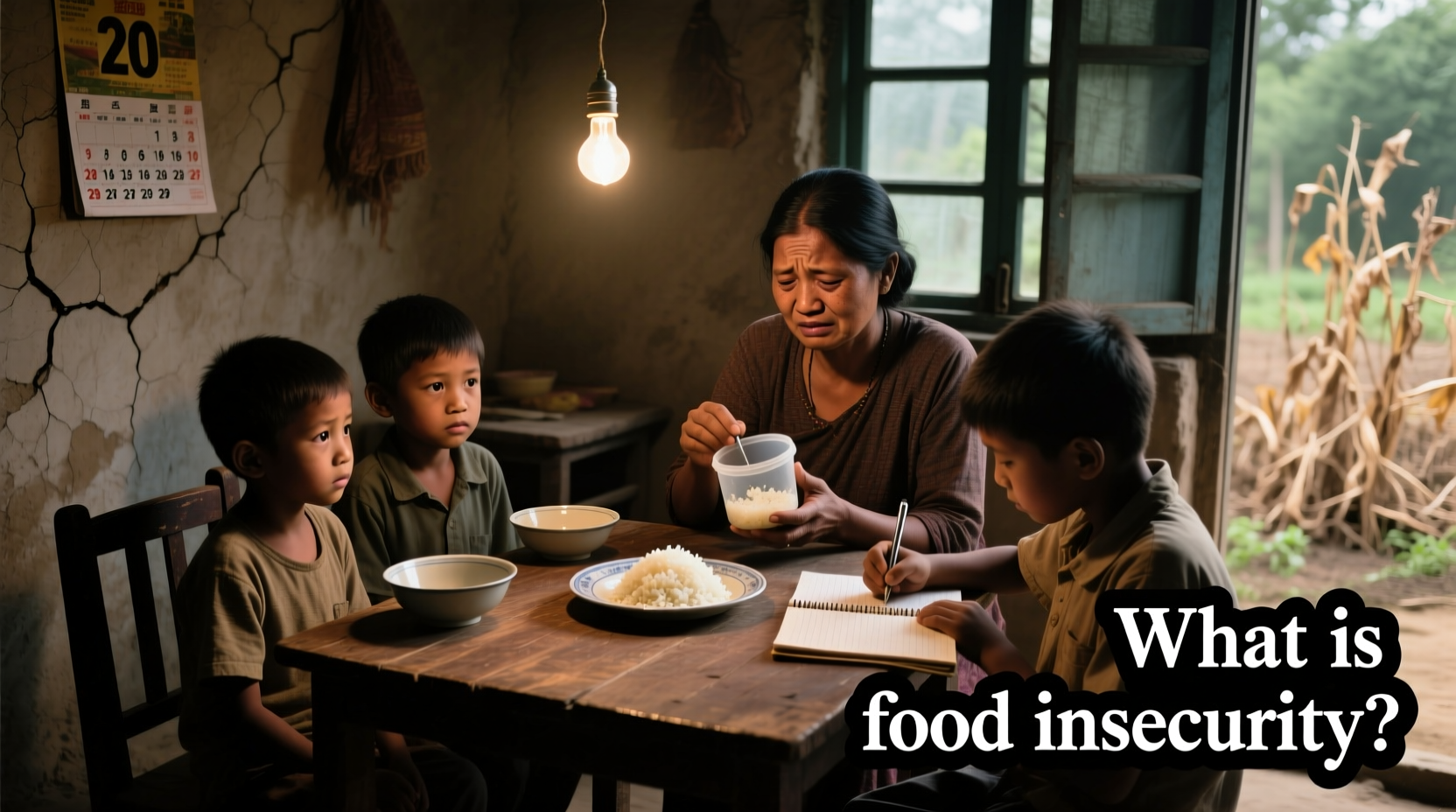Understanding food insecurity starts with recognizing it's not just about hunger. While hunger describes a physical sensation, food insecurity represents the socioeconomic condition that leads to hunger when households lack reliable access to sufficient food. This distinction matters because addressing food insecurity requires systemic solutions beyond immediate food provision.
Defining Food Insecurity: More Than Empty Stomachs
The United States Department of Agriculture (USDA) defines food insecurity as "a household-level economic and social condition of limited or uncertain access to adequate food." This definition captures three critical dimensions:
- Availability: Physical presence of food in markets and communities
- Accessibility: Economic and physical ability to obtain food
- Adequacy: Nutritional quality and cultural appropriateness of available food
Unlike temporary hunger, food insecurity reflects persistent challenges in obtaining food through normal channels. Households experiencing food insecurity often employ coping strategies like reducing meal sizes, skipping meals, or relying on inexpensive but nutritionally poor options.
| Concept | Definition | Scope |
|---|---|---|
| Food Insecurity | Limited/uncertain access to adequate food | Household socioeconomic condition |
| Hunger | Physical sensation of discomfort from insufficient food | Individual physiological experience |
| Poverty | Insufficient financial resources for basic needs | Broad economic condition |
| Famine | Extreme food shortage affecting large populations | Regional humanitarian emergency |
What Causes Food Insecurity? Understanding the Root Factors
Food insecurity stems from interconnected factors that disrupt the food system at multiple levels. Economic instability remains the primary driver, with job loss or reduced income immediately threatening food access. The USDA Economic Research Service identifies four key categories of causes:
Economic Factors
- Low wages that don't cover basic food costs
- Unemployment and underemployment
- High housing and healthcare costs consuming food budgets
- Limited access to financial services and credit
Environmental Challenges
- Climate change disrupting agricultural production
- Droughts, floods, and extreme weather events
- Soil degradation and water scarcity
- Pests and diseases affecting crops and livestock
Systemic Barriers
- Food deserts with limited grocery options
- Transportation challenges accessing food retailers
- Racial and socioeconomic disparities in food access
- Policy decisions affecting food assistance programs
Global Supply Chain Issues
- Trade restrictions and export bans
- Fuel price fluctuations affecting food transportation
- Conflict disrupting agricultural production and distribution
- Pandemics affecting food system workers

Measuring Food Insecurity: How We Track the Problem
Researchers use standardized survey tools to measure food insecurity prevalence. The USDA's Household Food Security Survey Module asks 18 questions about food access experiences over the previous 12 months. Responses determine whether households experience:
- High food security: No reported issues accessing food
- Marginal food security: Occasional anxiety about food access
- Low food security: Reduced quality or variety of diet
- Very low food security: Disrupted eating patterns and reduced food intake
The Food and Agriculture Organization (FAO) uses a different metric called the Food Insecurity Experience Scale (FIES) that assesses severity through eight questions. This allows global comparisons across different economic contexts.
Food Insecurity Trends: A 10-Year Perspective
- 2014: 14.0% of U.S. households food insecure (17.4 million households)
- 2017: Decline to 11.8% as economy improved
- 2020: Sharp increase to 10.5% during pandemic (13.8 million households)
- 2022: 12.8% of U.S. households food insecure, highest rate since 2014
- 2023: Global acute food insecurity affects 345 million people across 79 countries
Who Experiences Food Insecurity? Understanding Vulnerable Populations
Food insecurity doesn't affect all communities equally. Certain populations face higher risks due to systemic barriers and economic disadvantages:
- Households with children: 16.3% food insecurity rate (2022)
- Black households: 22.0% food insecurity rate
- Hispanic households: 17.8% food insecurity rate
- Rural communities: Higher rates due to transportation barriers
- Single-parent households: Especially mothers with young children
- Seniors on fixed incomes: 7.1% food insecurity rate
These disparities reflect deeper structural issues in our food system and economy. The Urban Institute notes that food insecurity rates among Black households remain consistently double those of white households, highlighting persistent racial inequities in food access.
Health and Social Consequences of Food Insecurity
Food insecurity creates ripple effects that extend far beyond empty stomachs. The American Journal of Public Health documents these concerning outcomes:
- Children: Higher rates of developmental delays, behavioral problems, and chronic health conditions
- Adults: Increased risk of diabetes, heart disease, and mental health disorders
- Economic impact: $160 billion annually in additional healthcare costs in the U.S.
- Educational impact: Food-insecure children score lower on academic achievement tests
Research published in the Journal of Nutrition shows that food-insecure adults are 62% more likely to develop diabetes than food-secure adults, even after controlling for other risk factors. This demonstrates how food insecurity creates long-term health burdens that strain healthcare systems.
Solutions That Work: Addressing Food Insecurity Effectively
Combating food insecurity requires multi-pronged approaches that address both immediate needs and root causes. Evidence-based strategies include:
Immediate Relief Programs
- SNAP (Supplemental Nutrition Assistance Program) benefits
- School meal programs for children
- Food banks and community food pantries
- WIC (Women, Infants, and Children) nutrition program
Systemic Solutions
- Living wage policies that cover basic food costs
- Expanding access to affordable housing and healthcare
- Supporting local food systems and urban agriculture
- Improving transportation to grocery stores in food deserts
Policy Interventions
- Strengthening federal nutrition assistance programs
- Implementing climate-resilient agricultural practices
- Addressing racial disparities in food access
- Supporting international food security initiatives
The Center on Budget and Policy Priorities found that SNAP alone lifted 2.7 million people out of poverty in 2021, including 1.2 million children. This demonstrates how targeted policy interventions can make meaningful differences in food security outcomes.
How You Can Help Reduce Food Insecurity
While systemic change is essential, individual actions also contribute to solutions:
- Support local food banks through donations or volunteering
- Advocate for policies that address root causes of food insecurity
- Reduce food waste in your household (40% of U.S. food gets wasted)
- Support community gardens and urban farming initiatives
- Educate others about food insecurity facts and solutions
Understanding what food insecurity means helps us move beyond simplistic explanations and toward effective solutions. By recognizing its complex causes and disproportionate impacts, we can build more resilient food systems that ensure everyone has access to adequate, nutritious food.











 浙公网安备
33010002000092号
浙公网安备
33010002000092号 浙B2-20120091-4
浙B2-20120091-4